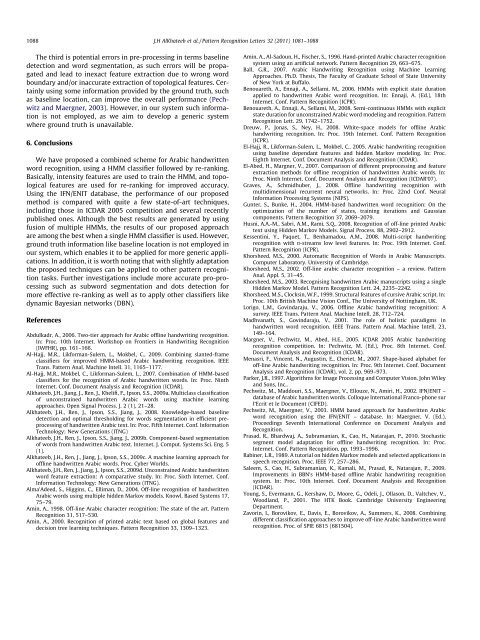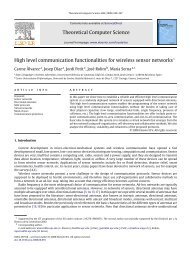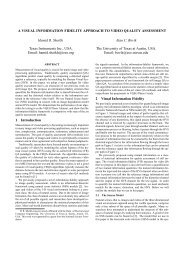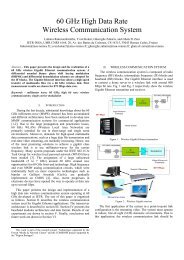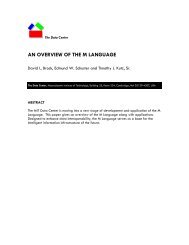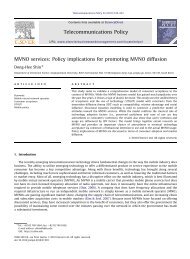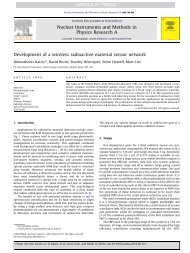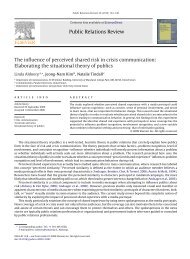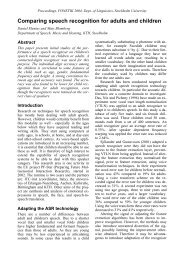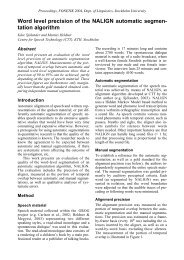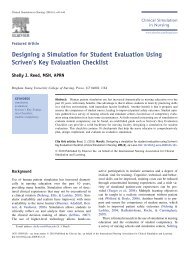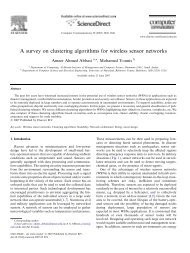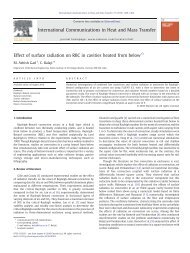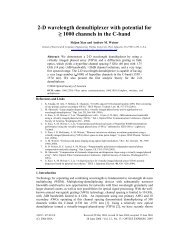Offline handwritten Arabic cursive text recognition using Hidden ...
Offline handwritten Arabic cursive text recognition using Hidden ...
Offline handwritten Arabic cursive text recognition using Hidden ...
Create successful ePaper yourself
Turn your PDF publications into a flip-book with our unique Google optimized e-Paper software.
1088 J.H AlKhateeb et al. / Pattern Recognition Letters 32 (2011) 1081–1088<br />
The third is potential errors in pre-processing in terms baseline<br />
detection and word segmentation, as such errors will be propagated<br />
and lead to inexact feature extraction due to wrong word<br />
boundary and/or inaccurate extraction of topological features. Certainly<br />
<strong>using</strong> some information provided by the ground truth, such<br />
as baseline location, can improve the overall performance (Pechwitz<br />
and Maergner, 2003). However, in our system such information<br />
is not employed, as we aim to develop a generic system<br />
where ground truth is unavailable.<br />
6. Conclusions<br />
We have proposed a combined scheme for <strong>Arabic</strong> <strong>handwritten</strong><br />
word <strong>recognition</strong>, <strong>using</strong> a HMM classifier followed by re-ranking.<br />
Basically, intensity features are used to train the HMM, and topological<br />
features are used for re-ranking for improved accuracy.<br />
Using the IFN/ENIT database, the performance of our proposed<br />
method is compared with quite a few state-of-art techniques,<br />
including those in ICDAR 2005 competition and several recently<br />
published ones. Although the best results are generated by <strong>using</strong><br />
fusion of multiple HMMs, the results of our proposed approach<br />
are among the best when a single HMM classifier is used. However,<br />
ground truth information like baseline location is not employed in<br />
our system, which enables it to be applied for more generic applications.<br />
In addition, it is worth noting that with slightly adaptation<br />
the proposed techniques can be applied to other pattern <strong>recognition</strong><br />
tasks. Further investigations include more accurate pro-processing<br />
such as subword segmentation and dots detection for<br />
more effective re-ranking as well as to apply other classifiers like<br />
dynamic Bayesian networks (DBN).<br />
References<br />
Abdulkadr, A., 2006. Two-tier approach for <strong>Arabic</strong> offline handwriting <strong>recognition</strong>.<br />
In: Proc. 10th Internet. Workshop on Frontiers in Handwriting Recognition<br />
(IWFHR), pp. 161–166.<br />
Al-Hajj, M.R., Likforman-Sulem, L., Mokbel, C., 2009. Combining slanted-frame<br />
classifiers for improved HMM-based <strong>Arabic</strong> handwriting <strong>recognition</strong>. IEEE<br />
Trans. Pattern Anal. Machine Intell. 31, 1165–1177.<br />
Al-Hajj, M.R., Mokbel, C., Likforman-Sulem, L., 2007. Combination of HMM-based<br />
classifiers for the <strong>recognition</strong> of <strong>Arabic</strong> <strong>handwritten</strong> words. In: Proc. Ninth<br />
Internet. Conf. Document Analysis and Recognition (ICDAR).<br />
Alkhateeb, J.H., Jiang, J., Ren, J., Khelifi, F., Ipson, S.S., 2009a. Multiclass classification<br />
of unconstrained <strong>handwritten</strong> <strong>Arabic</strong> words <strong>using</strong> machine learning<br />
approaches. Open Signal Process. J. 2 (1), 21–28.<br />
Alkhateeb, J.H., Ren, J., Ipson, S.S., Jiang, J., 2008. Knowledge-based baseline<br />
detection and optimal thresholding for words segmentation in efficient preprocessing<br />
of <strong>handwritten</strong> <strong>Arabic</strong> <strong>text</strong>. In: Proc. Fifth Internet. Conf. Information<br />
Technology: New Generations (ITNG)<br />
Alkhateeb, J.H., Ren, J., Ipson, S.S., Jiang, J., 2009b. Component-based segmentation<br />
of words from <strong>handwritten</strong> <strong>Arabic</strong> <strong>text</strong>. Internet. J. Comput. Systems Sci. Eng. 5<br />
(1).<br />
Alkhateeb, J.H., Ren, J., Jiang, J., Ipson, S.S., 2009c. A machine learning approach for<br />
offline <strong>handwritten</strong> <strong>Arabic</strong> words. Proc. Cyber Worlds.<br />
Alkhateeb, J.H., Ren, J., Jiang, J., Ipson, S.S., 2009d. Unconstrained <strong>Arabic</strong> <strong>handwritten</strong><br />
word feature extraction: A comparative study. In: Proc. Sixth Internet. Conf.<br />
Information Technology: New Generations (ITNG).<br />
Alma’Adeed, S., Higgins, C., Elliman, D., 2004. Off-line <strong>recognition</strong> of <strong>handwritten</strong><br />
<strong>Arabic</strong> words <strong>using</strong> multiple hidden Markov models. Knowl. Based Systems 17,<br />
75–79.<br />
Amin, A., 1998. Off-line <strong>Arabic</strong> character <strong>recognition</strong>: The state of the art. Pattern<br />
Recognition 31, 517–530.<br />
Amin, A., 2000. Recognition of printed arabic <strong>text</strong> based on global features and<br />
decision tree learning techniques. Pattern Recognition 33, 1309–1323.<br />
Amin, A., Al-Sadoun, H., Fischer, S., 1996. Hand-printed <strong>Arabic</strong> character <strong>recognition</strong><br />
system <strong>using</strong> an artificial network. Pattern Recognition 29, 663–675.<br />
Ball, G.R., 2007. <strong>Arabic</strong> Handwriting Recognition <strong>using</strong> Machine Learning<br />
Approaches. Ph.D. Thesis, The Faculty of Graduate School of State University<br />
of New York at Buffalo.<br />
Benouareth, A., Ennaji, A., Sellami, M., 2006. HMMs with explicit state duration<br />
applied to <strong>handwritten</strong> <strong>Arabic</strong> word <strong>recognition</strong>. In: Ennaji, A. (Ed.), 18th<br />
Internet. Conf. Pattern Recognition (ICPR).<br />
Benouareth, A., Ennaji, A., Sellami, M., 2008. Semi-continuous HMMs with explicit<br />
state duration for unconstrained <strong>Arabic</strong> word modeling and <strong>recognition</strong>. Pattern<br />
Recognition Lett. 29, 1742–1752.<br />
Dreuw, P., Jonas, S., Ney, H., 2008. White-space models for offline <strong>Arabic</strong><br />
handwriting <strong>recognition</strong>. In: Proc. 19th Internet. Conf. Pattern Recognition<br />
(ICPR).<br />
El-Hajj, R., Likforman-Sulem, L., Mokbel, C., 2005. <strong>Arabic</strong> handwriting <strong>recognition</strong><br />
<strong>using</strong> baseline dependant features and hidden Markov modeling. In: Proc.<br />
Eighth Internet. Conf. Document Analysis and Recognition (ICDAR).<br />
El-Abed, H., Margner, V., 2007. Comparison of different preprocessing and feature<br />
extraction methods for offline <strong>recognition</strong> of <strong>handwritten</strong> <strong>Arabic</strong> words. In:<br />
Proc. Ninth Internet. Conf. Document Analysis and Recognition (ICDAR’07).<br />
Graves, A., Schmidhuber, J., 2008. <strong>Offline</strong> handwriting <strong>recognition</strong> with<br />
multidimensional recurrent neural networks. In: Proc. 22nd Conf. Neural<br />
Information Processing Systems (NIPS).<br />
Gunter, S., Bunke, H., 2004. HMM-based <strong>handwritten</strong> word <strong>recognition</strong>: On the<br />
optimization of the number of states, training iterations and Gaussian<br />
components. Pattern Recognition 37, 2069–2079.<br />
Husni, A.A.-M., Sabri, A.M., Rami, S.Q., 2008. Recognition of off-line printed <strong>Arabic</strong><br />
<strong>text</strong> <strong>using</strong> <strong>Hidden</strong> Markov Models. Signal Process. 88, 2902–2912.<br />
Kessentini, Y., Paquet, T., Benhamadou, A.M., 2008. Multi-script handwriting<br />
<strong>recognition</strong> with n-streams low level features. In: Proc. 19th Internet. Conf.<br />
Pattern Recognition (ICPR).<br />
Khorsheed, M.S., 2000. Automatic Recognition of Words in <strong>Arabic</strong> Manuscripts.<br />
Computer Laboratory. University of Cambridge.<br />
Khorsheed, M.S., 2002. Off-line arabic character <strong>recognition</strong> – a review. Pattern<br />
Anal. Appl. 5, 31–45.<br />
Khorsheed, M.S., 2003. Recognising <strong>handwritten</strong> <strong>Arabic</strong> manuscripts <strong>using</strong> a single<br />
<strong>Hidden</strong> Markov Model. Pattern Recognition Lett. 24, 2235–2242.<br />
Khorsheed, M.S., Clocksin, W.F., 1999. Structural features of <strong>cursive</strong> <strong>Arabic</strong> script. In:<br />
Proc. 10th British Machine Vision Conf., The University of Nottingham, UK.<br />
Lorigo, L.M., Govindaraju, V., 2006. <strong>Offline</strong> <strong>Arabic</strong> handwriting <strong>recognition</strong>: A<br />
survey. IEEE Trans. Pattern Anal. Machine Intell. 28, 712–724.<br />
Madhvanath, S., Govindaraju, V., 2001. The role of holistic paradigms in<br />
<strong>handwritten</strong> word <strong>recognition</strong>. IEEE Trans. Pattern Anal. Machine Intell. 23,<br />
149–164.<br />
Margner, V., Pechwitz, M., Abed, H.E., 2005. ICDAR 2005 <strong>Arabic</strong> handwriting<br />
<strong>recognition</strong> competition. In: Pechwitz, M. (Ed.), Proc. 8th Internet. Conf.<br />
Document Analysis and Recognition (ICDAR).<br />
Menasri, F., Vincent, N., Augustin, E., Cheriet, M., 2007. Shape-based alphabet for<br />
off-line <strong>Arabic</strong> handwriting <strong>recognition</strong>. In: Proc. 9th Internet. Conf. Document<br />
Analysis and Recognition (ICDAR), vol. 2, pp. 969–973.<br />
Parker, J.R., 1997. Algorithms for Image Processing and Computer Vision. John Wiley<br />
and Sons, Inc..<br />
Pechwitz, M., Maddouri, S.S., Maergner, V., Ellouze, N., Amiri, H., 2002. IFN/ENIT –<br />
database of <strong>Arabic</strong> <strong>handwritten</strong> words. Colloque International Franco-phone sur<br />
l’Ecrit et le Document (CIFED).<br />
Pechwitz, M., Maergner, V., 2003. HMM based approach for <strong>handwritten</strong> <strong>Arabic</strong><br />
word <strong>recognition</strong> <strong>using</strong> the IFN/ENIT – database. In: Maergner, V. (Ed.),<br />
Proceedings Seventh International Conference on Document Analysis and<br />
Recognition.<br />
Prasad, R., Bhardwaj, A., Subramanian, K., Cao, H., Natarajan, P., 2010. Stochastic<br />
segment model adaptation for offline handwriting <strong>recognition</strong>. In: Proc.<br />
Internet. Conf. Pattern Recognition, pp. 1993–1996.<br />
Rabiner, L.R., 1989. A tutorial on hidden Markov models and selected applications in<br />
speech <strong>recognition</strong>. Proc. IEEE 77, 257–286.<br />
Saleem, S., Cao, H., Subramanian, K., Kamali, M., Prasad, R., Natarajan, P., 2009.<br />
Improvements in BBN’s HMM-based offline <strong>Arabic</strong> handwriting <strong>recognition</strong><br />
system. In: Proc. 10th Internet. Conf. Document Analysis and Recognition<br />
(ICDAR).<br />
Young, S., Evermann, G., Kershaw, D., Moore, G., Odeli, J., Ollason, D., Valtchev, V.,<br />
Woodland, P., 2001. The HTK Book. Cambridge University Engineering<br />
Department.<br />
Zavorin, I., Borovikov, E., Davis, E., Borovikov, A., Summers, K., 2008. Combining<br />
different classification approaches to improve off-line <strong>Arabic</strong> <strong>handwritten</strong> word<br />
<strong>recognition</strong>. Proc. of SPIE 6815 (681504).


